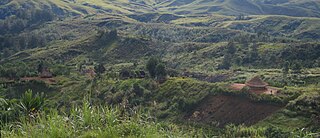Usarufa language

| Usarufa | |
|---|---|
| Region | Okapa District, Eastern Highlands Province, Papua New Guinea |
Native speakers | (1,300 cited 1996)[1] |
| Language codes | |
| ISO 639-3 | usa |
| Glottolog | usar1243 |
 Imikori Village, from Moife Hill | |
Usarufa is a Kainantu language spoken by the people of the same name in Papua New Guinea. It belongs to the Gauwa branch of the Kainantu family of the Kainantu–Goroka languages. The language area consists of six villages: Moife, Imikori, Irafo, Kagu, Agura 1, and Agura 2. Its ISO 639 code is usa.
As of 2009, the language was reported to have had about 1200 speakers and no fluent speakers below the age of 25, which makes it an endangered language.
Phonology
[edit]This section is derived from the analyses presented in Bee 1965 in which an inventory of eighteen consonants is favoured.[2]
| Labial | Alveolar | Palatal | Velar | Glottal | ||
|---|---|---|---|---|---|---|
| Plosive | plain | p | t | k | ʔ | |
| glottalised | ˀp | ˀt | ˀk | |||
| Nasal | plain | m | n | |||
| glottalised | ˀm | ˀn | ||||
| geminate | mː | nː | ||||
| Approximant | plain | w | ɾ | j | ||
| glottalised | ˀw | ˀj | ||||
The distribution of these consonants is determined by their position within a stress group, a segment which has one primary stress, the placement of which is determined by a pitch contour. This stress group may consist of two or more syllables. Only /p t k m n w j/ can occur as the onset of a stress group, and only /ʔ/ can occur finally. In stress-medial position all consonant phonemes can occur, and /p k/ are realised as [β] and [ɣ], respectively. /ɾ/ may be realised as [ɺ].
An alternative analysis treats all glottalised and geminate consonants as secondary, in which case there are only nine consonant phonemes:
| Labial | Alveolar | Palatal | Velar | Glottal | |
|---|---|---|---|---|---|
| Plosive | p | t | k | ʔ | |
| Nasal | m | n | |||
| Approximant | w | r | j |
Usarufa has an unremarkable five-vowel system.
| Front | Central | Back | |
|---|---|---|---|
| Close | i | u | |
| Mid | e | o | |
| Open | a |
/i/, /e/, and /a/ have the allophones [ɪ], [ɛ] and [ʌ], respectively. /e/ may be realised as [ɪ] following coronal or palatal phonemes.
See also
[edit]- Vida Chenoweth, who studied the Usarufa music
- Aikuma, mobile software for language recording, first used to record Usarufa
References
[edit]- ^ Usarufa at Ethnologue (18th ed., 2015) (subscription required)
- ^ Bee, Darlene (1965). "Usarufa Distinctive Features and Phonemes" (PDF). In Bee, Darlene (ed.). Papers in New Guinea Linguistics 4. Pacific Linguistics Series A. Vol. 6. Australian National University. pp. 39–68. doi:10.15144/PL-A6.39.
External links
[edit]- Chenoweth, Vida. "The Usarufas and Their Music" (PDF).
- OLAC Resources in and about the Usarufa Language
- Bird, Steven. "Experiencing language death". Language Log. Retrieved 2009-06-26.
- Paradisec has a collection of Stephen A Wurm's materials (SAW3) that include Usarufa materials.